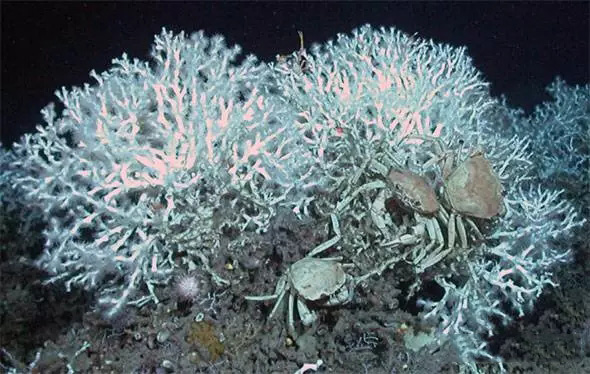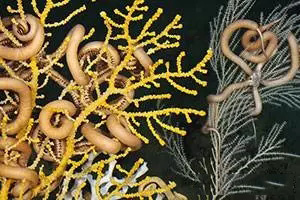When we think of coral reefs, clear, warm waters; gently swaying sea fans; brightly colored fish tend to spring to mind. The reefs we'll be exploring on this expedition live in a different habitat than shallow reefs, but are very similar in many ways.

Deep-sea corals are defined as corals that live at depths greater than 50 meters, but most species live in the deep ocean at depths of several hundred meters, in cold, dark, rocky habitats, often far from shore. Unlike shallow-water reefs, which are limited to warm tropical waters, deep-sea corals are found throughout the world's oceans, from the tropics to the polar regions. Like shallow corals, deep-sea reefs are created by stony corals that have formed large geological structures over thousands of years.
While there are many species of corals that build reefs in shallow water, including hundreds of species, only 6 deep-sea stony corals can create reefs. The most common of these is "Lophelia pertusa," which forms huge coral reefs in the Atlantic Ocean, including the Gulf of Mexico and the South Atlantic Gulf.
Shallow-water corals rely on photosynthetic algae within the coral to provide nutrients to their hosts. However, algae cannot survive in the absence of light, so deep-sea corals need to rely on other food sources for their nutrients, either through organic material falling from the surface or by feeding on small plankton. Because deep-sea corals lack algae, they are bright white in color rather than the browns and greens we see on shallow reefs. Other species of coral, such as gorgonians, black corals, and soft corals, add variety and color to deep-sea coral ecosystems.

This image shows the diversity of deep-sea coral species, including two octopus coral groups,
or sea fans (yellow and light grey polyps), a stony coral (white Lophelia pertusa), and a sea brevet (star brevis)
Like shallow reefs, deep-sea corals form structures that provide habitat for other invertebrates and fish, some of which are economically valuable. The death of shallow coral reefs due to human influence has been documented for many years, and although they are very deep and have the greatest distance from the shore, deep-sea corals have not suffered from human influence in any way.
As coastal resources were depleted, humans began to search more deeply for new food and energy sources. The biggest impact on deep-sea corals comes from commercial bottom trawling, which uses heavy equipment to catch deep-sea fish and, in the process, destroy structures that grow on the seafloor, such as deep-sea corals. This type of fishing has damaged large areas of deep-sea coral reefs in domestic and international waters.
Corals are also harvested directly for their black, red or gold skeletons for use in jewelry and jewelry. These "precious corals" are thought to be ancient and slow-growing -- in fact, the oldest known animal on Earth is a black coral that's over 4,250 years old.

Deep-sea corals are often found in oil and gas extraction areas, so drilling mud and oil spills have the potential to cause damage. Deep-sea mining is fast becoming a reality, with large-scale exploration and exploitation of the high seas. These miners are large and may permanently remove large areas of deep-sea coral habitat. In addition, the future effects of climate change are less clear, but warmer temperatures may alter species distribution, and increased acidity may weaken coral skeletons, especially in the deep ocean, where the effects of ocean acidification are thought to be greatest.
Much of the deep-sea coral research in the Gulf of Mexico has been concentrated in the northern regions where energy interests are concentrated, with relatively little in the eastern Gulf. One of the main purposes of the expedition was to explore and characterize deep-sea coral communities on the slopes of western Florida. Early surveys in this area uncovered large and thriving Lophelia reefs, as well as large black coral gatherings. However, multibeam surveys have revealed vast areas where there are many other promising properties that have never been explored.
Some known coral habitats have been proposed as habitats of special concern (HAPC) and any additional information we provide will help support this process, as well as other management and conservation measures. While the establishment of new protected areas cannot completely prevent damage from oil spills or climate change, these areas can improve coral health and resilience in the face of future threats.